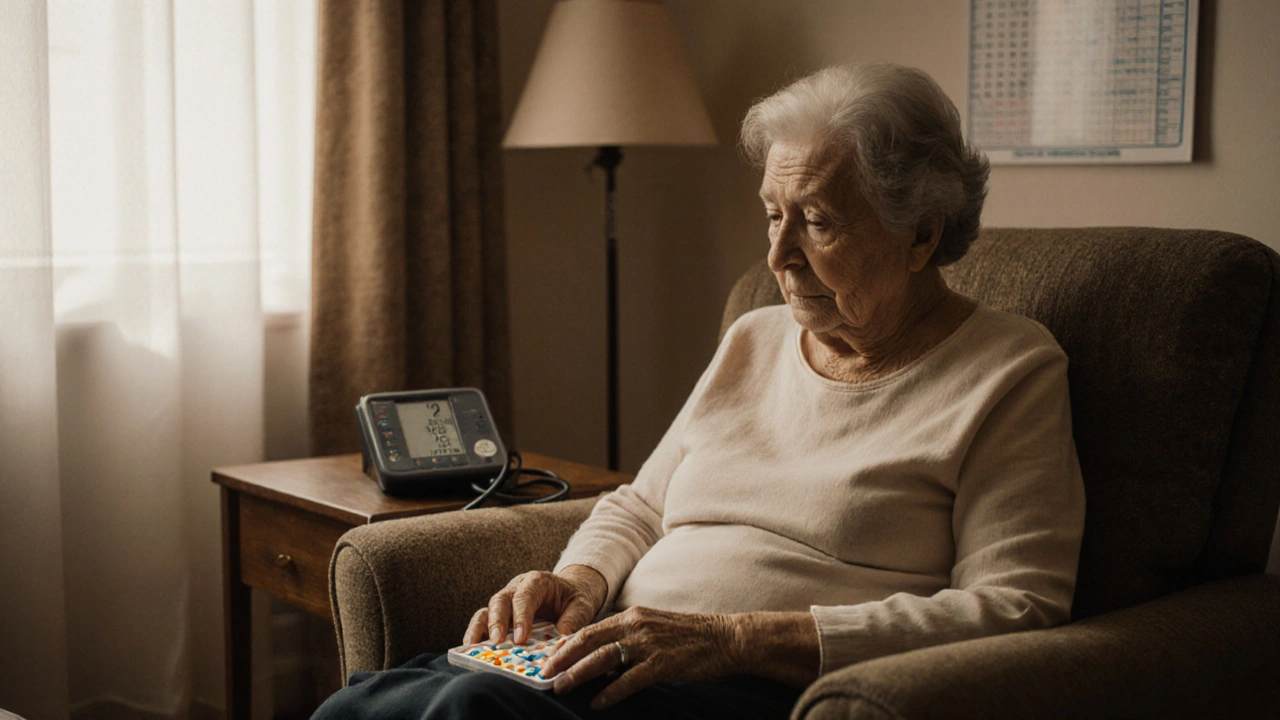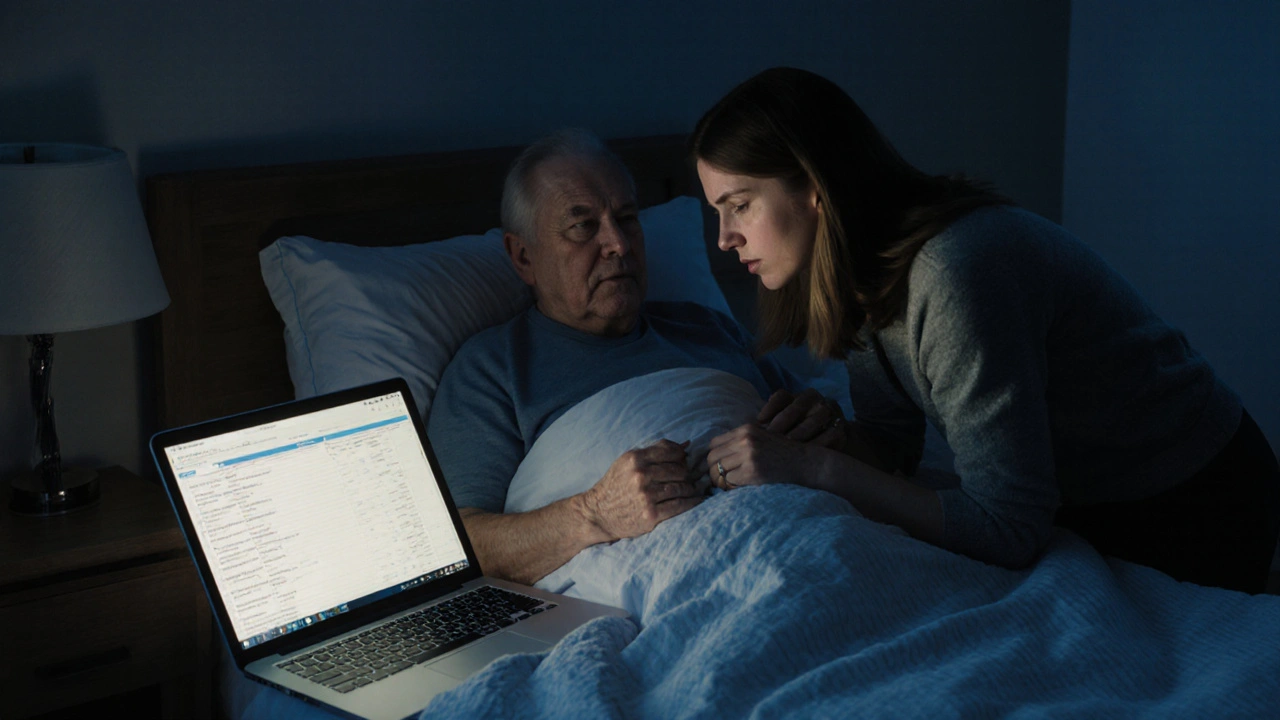How Illness Affects the Aging Population - Health Impacts & Costs
 Sep, 29 2025
Sep, 29 2025
Preventive Care Savings Calculator
This tool estimates how much annual healthcare cost savings could be achieved by implementing preventive care measures for older adults with multiple chronic conditions.
When disease strikes later in life, the ripple effects go far beyond a simple doctor’s visit. Understanding how sickness reshapes the lives of older adults helps families, policymakers, and health workers plan smarter solutions.
Quick Summary
- Chronic illnesses affect up to 80% of people over 65, driving up medical expenses and caregiving needs.
- Health problems accelerate cognitive decline, limit mobility, and increase social isolation.
- Preventive care and community programs can cut costs by up to 30% and improve quality of life.
Aging Population refers to the segment of society typically aged 65 and older, a group that is growing faster than any other age bracket in developed nations. In 2025, Australia alone sees more than 3.5 million citizens in this bracket, a number projected to double by 2050.
Why Sickness Hits Older Adults Harder
Age‑related changes in the immune system, known as immunosenescence, reduce the body’s ability to fight off infections and heal wounds. Combine that with the higher likelihood of Chronic Disease - such as heart disease, diabetes, or arthritis - and the health landscape becomes a maze of overlapping challenges.
For example, a 72‑year‑old with hypertension who also develops osteoarthritis faces medication interactions, limited exercise options, and a higher risk of falls. Each additional condition compounds the strain on the body and the health system.
Economic Toll: Rising Healthcare Costs
Medical spending on the aging population now accounts for nearly 40% of national health budgets in many OECD countries. Hospital admissions for preventable complications, like urinary tract infections, cost an average of $9,800 per episode in Australia.
Long‑term care facilities charge between $200 and $350 per day, depending on location and level of support. When a loved one requires 24‑hour supervision, families can see annual expenses skyrocket beyond $70,000.
These numbers aren’t just abstract; they influence policy debates about Medicare reforms, aged‑care subsidies, and private insurance premiums.
Physical Fallout: Mobility Limitations and Cognitive Decline
Joint pain and muscle weakness make everyday tasks - like climbing stairs or grocery shopping - exhausting. A national survey found that 42% of seniors report difficulty walking a short distance without assistance.
Simultaneously, chronic inflammation and vascular issues speed up cognitive aging. Approximately 15% of Australians over 70 show early signs of dementia, a figure that climbs sharply when multiple illnesses coexist.
The combination of limited movement and shrinking mental sharpness fuels a dangerous cycle: less activity leads to faster decline, which then reduces the desire or ability to stay active.

Emotional Ripple: Social Isolation and Mental Health
When illness restricts outings, many older adults lose regular contact with friends and community groups. Social isolation isn’t just lonely; it raises the risk of depression by 30% and is linked to higher mortality rates.
Family members often notice mood swings or reduced appetite, but may attribute these signs to “just getting old” rather than a treatable condition.
Who Pays the Price? Caregiver Burden
Informal caregivers - often spouses, adult children, or close friends - shoulder 70% of daily care tasks for seniors with chronic illnesses. The average caregiver dedicates 20 hours per week, and nearly one‑third report symptoms of burnout, such as chronic fatigue and anxiety.
Financially, caregivers may cut back on work hours, losing an estimated $5,000 to $10,000 in earnings annually. This hidden cost ripples through household budgets and national economies alike.
Turning the Tide: The Power of Preventive Care
Regular screenings, vaccinations, and lifestyle coaching can slash hospital admissions by up to 30%. A community‑based fall‑prevention program in Adelaide reduced emergency visits by 22% among participants over a 12‑month period.
Nutrition counseling that emphasizes protein intake and vitamin D supplementation improves muscle mass, aiding mobility and reducing fracture risk.
Technology also plays a role: remote monitoring devices alert caregivers to abnormal heart rates or medication non‑adherence, allowing early intervention.
Policy Playbook: Supporting a Healthier Aging Society
Governments can invest in integrated care models that bring doctors, physiotherapists, and social workers onto a single platform. Such models have shown a 15% reduction in duplicated tests and a smoother patient journey.
Expanding subsidies for home‑based aides relieves pressure on families and delays costly moves to residential facilities.
Finally, public health campaigns that destigmatize aging and highlight the benefits of staying active encourage older adults to seek preventive services before problems arise.
Key Takeaways
- Illness dramatically raises health expenses and caregiving demands for older adults.
- Physical and cognitive declines are interlinked and exacerbate social isolation.
- Preventive measures and coordinated care can cut costs and boost quality of life.
- Policy support for home care, integrated services, and community programs is essential.
| Condition | Prevalence (%) | Average Annual Cost (AUD) |
|---|---|---|
| Hypertension | 58 | 1,300 |
| Type2 Diabetes | 22 | 2,100 |
| Osteoarthritis | 45 | 1,800 |
| Chronic Obstructive Pulmonary Disease (COPD) | 12 | 2,500 |
| Dementia (any type) | 10 | 3,600 |

Frequently Asked Questions
How does chronic illness increase healthcare costs for seniors?
Multiple conditions often require overlapping medications, more frequent doctor visits, and higher rates of hospitalization. Each added condition can raise annual expenses by 15‑30%.
What are the most effective preventive measures for older adults?
Vaccinations (flu, pneumococcal), regular blood pressure and cholesterol checks, strength‑building exercise programs, and balanced nutrition with adequate protein and vitaminD are proven to reduce hospitalizations.
How can families lessen caregiver burnout?
Respite services, caregiving support groups, and technology‑assisted monitoring can give caregivers needed breaks and reduce stress.
Is home‑based care more cost‑effective than residential aged‑care?
Yes. Studies show home‑based care can be 20‑40% cheaper while maintaining similar health outcomes, especially when integrated with community health resources.
What role does technology play in managing senior health?
Wearable devices track heart rate, sleep, and activity; telehealth platforms provide remote consultations; and medication reminders improve adherence, all lowering risk of acute events.
Lynn Kline
September 29, 2025 AT 19:15Wow, what a comprehensive look at senior health-truly eye‑opening! 🌟 The stats on chronic conditions are staggering, and the preventive‑care calculator is a game‑changer! 🎉 It's amazing how a few lifestyle tweaks can slash costs by up to thirty percent-who wouldn't want that? Keep spreading the word, because knowledge is the first step to better health for our elders! 🙌
Rin Jan
September 30, 2025 AT 15:32I have to say that the way we treat our aging population is a moral litmus test for any society. we should be ashamed if we turn a blind eye to the suffering of seniors. I read the statistics on chronic illnesses and felt a deep sense of responsibility. I cannot stress enough how preventable many of these hospitalizations are. I see families stretched thin caring for loved ones and it breaks my heart. we owe it to our elders to invest in preventive programs. ignoring these costs is not only fiscally stupid but ethically bankrupt. I have seen communities that implement fall‑prevention classes and watch the emergency visits plummet. I have also seen how nutrition counseling can rebuild muscle and reduce fractures. small interventions have huge ripple effects. I am confident that policymakers will finally listen because the data is undeniable. I urge every reader to advocate for better home‑based care subsidies. I am hopeful that together we can change the narrative. I know that change is hard but the stakes are too high to stay idle. I hope this post inspires action. we must act before the next generation inherits an unsustainable burden.
Jessica Taranto
October 1, 2025 AT 11:48You’ve highlighted key data points, and it’s clear that community programs matter. The calculator is a useful tool for families planning ahead.
akash chaudhary
October 2, 2025 AT 08:05The article correctly states that chronic disease prevalence is high, but it misrepresents the cost per hospital admission-$9,800 is the average for acute events, not all preventable cases. Moreover, the claim that home‑based care is 20‑40% cheaper should be qualified with the specific care models referenced. Precision matters when influencing policy.
Adele Joablife
October 3, 2025 AT 04:22While the numbers are compelling, we must remember that not every senior will benefit equally from a blanket preventive approach. Tailoring interventions to individual risk profiles yields better outcomes.
kenneth strachan
October 4, 2025 AT 00:38Definately, the emotional toll on caregivers is a silent crisis-one that many ignore! Yet, the data does not lie; watch those statistics climb, and you'll see why we need immediate action! It's heartbreaking to think families are forced to choose between work and love!
Mandy Mehalko
October 4, 2025 AT 20:55I truly believe that with small changes like regular walks and vitamin D, seniors can enjoy brighter days ahead. Lets keep sharing these ideas widely!
Bryan Kopp
October 5, 2025 AT 17:12Our country must lead the way in senior care innovation.
Patrick Vande Ven
October 6, 2025 AT 13:28The presented evidence underscores the fiscal imperative of integrating multidisciplinary teams into elder care. By consolidating resources, the healthcare system can achieve measurable reductions in redundant testing and associated expenditures.
Tim Giles
October 7, 2025 AT 09:45The interplay between immunosenescence and comorbidities creates a complex clinical landscape that challenges conventional management protocols. In this context, preventive strategies such as annual vaccinations and structured exercise regimens serve as critical buffers against acute decompensation. Moreover, the economic analyses indicate that each avoided hospital admission translates into substantial savings for both private insurers and public health budgets. It is therefore essential for policymakers to allocate funding toward community‑based initiatives that have demonstrable efficacy. Additionally, technology‑enabled monitoring can provide early warnings of physiological derangements, thereby facilitating timely interventions. The integration of telehealth services further expands access for geographically isolated seniors, reducing travel burdens and associated costs. By embracing a holistic approach, we not only improve quality of life but also attenuate the financial pressures on the healthcare system. Consequently, the data presented should inform a strategic shift toward preventive care models.
Peter Jones
October 8, 2025 AT 06:02Great synthesis of the challenges and opportunities; I think this can spark constructive discussions among stakeholders.
Gerard Parker
October 9, 2025 AT 02:18Listen up-if you’re still doubting the value of preventive care, the numbers speak louder than any anecdote. Implement integrated care pathways now, and you’ll see a rapid decline in costly admissions. This is not a suggestion; it’s a demand backed by solid evidence.
Thomas Burke
October 9, 2025 AT 22:35Check out the calculator-it’s simple and useful.
Jessica Martins
October 10, 2025 AT 18:52Thank you for compiling these statistics; they provide a clear foundation for future research.
Doug Farley
October 11, 2025 AT 15:08Oh sure, just throw more money at programs and expect miracles-because that’s never backfired before.
Jeremy Olson
October 12, 2025 AT 11:25I understand the burden caregivers face, and I appreciate the emphasis on respite services as a vital support.
Ada Lusardi
October 13, 2025 AT 07:42Wow, this really hits home! 🌈💪 Let’s keep the momentum going! 🚀
Calvin Smith
October 14, 2025 AT 03:58Ah, another masterpiece of data brilliance-just what we needed to solve the aging crisis in a snap!